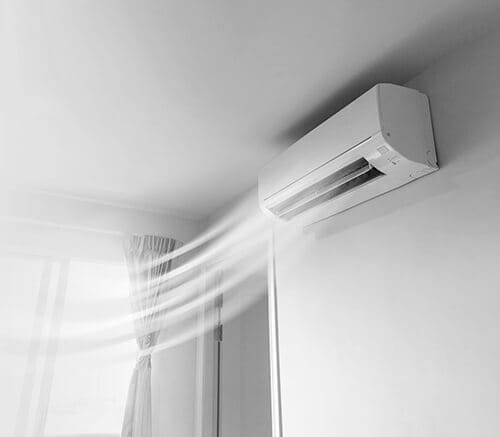
Most new homes in San Antonio and other areas in Texas are usually built with a ductwork system to provide central air conditioning and heating when required. In other colder parts of the country, it is extremely rare to find a home without ductwork due to the increased need for heating during the winter. However, the warmer winters in Texas mean that many older homes don’t have an existing ductwork system, and this obviously limits your options for air conditioning.
In this situation, most people end up turning to options like portable air conditioners and window units to help keep their home cool during the summer. While these options can help, a ductless mini-split is definitely the better choice. To understand why, let’s look at what a ductless mini-split AC is and how it provides air conditioning in homes without a central ductwork system.
What Is a Ductless Mini-Split AC?
Ductless mini-splits are quite similar to central AC systems in a number of ways. Both systems have an AC condenser that sits on a concrete pad outside the home. This unit provides cold refrigerant to the air handler inside and also disperses the heat the system absorbed from the building back into the air outside. The main difference between the two is how the air handler unit absorbs heat and circulates the cooled air.
In a central AC system, the evaporator coil and the blower fan are two separate units. The blower fan circulates air throughout the house by drawing warm air in through the return-air vents. This warm air is forced over the cold evaporator coil, and the refrigerant inside the coil absorbs heat from the air. Finally, the blower fan circulates this cooled air through the duct system and pumps it out of the supply vents throughout the home.
In a ductless mini-split system, this entire process occurs within the air handler unit mounted on your wall or ceiling. Instead of relying on ductwork, the air handler draws hot air in from the room itself. Inside this unit is a smaller version of an evaporator coil. This takes heat out of the air using cold refrigerant, and then the fan inside the air handler blows the cooled air back into the room.
Since there is no ductwork to circulate air, a ductless mini-split can only cool the air in its immediate vicinity. This means that the air handler can only provide cooling to one room or smaller area. However, the other major difference between this type of system and a central AC is that a ductless AC condenser can run multiple air handlers at the same time. This means that it is possible to install one condenser unit and connect it to multiple air handlers to potentially provide air conditioning for the entire home.
That being said, if you have a large home, it will likely be necessary to install more than one condenser. This is because each air handler usually needs to be located within 100 to 150 feet of the condenser. As well, most mini-split condensers can only accommodate up to eight air handlers.
This type of setup that uses more than one air handler is sometimes referred to as a multi-split system. In terms of purchase price, a multi-split system usually costs around the same or even more than buying a central AC unit. However, a multi-split system is cheaper in terms of installation and will cost far less than retrofitting your home with ductwork. Adding ductwork to a home that doesn’t have it is often not possible due to a lack of space. Even if there is enough room, it will likely cost you several thousand dollars and require major renovation that could easily take a few weeks.
How Are Ductless Mini-Splits Installed?
One of the biggest benefits of ductless mini-splits is that they are easy to install and don’t require any major construction work. If you don’t already have a suitable concrete pad for the outdoor condenser unit to sit on, you will need to have one poured. This can add a few hundred dollars onto the installation cost. It will also add a few extra days since you will first need to wait for the concrete to harden and cure before the condenser can be set.
Once the condenser unit is mounted, the rest of the installation is fairly quick and easy. In most cases, a skilled AC technician can install each air handler in only a few hours. The first step is to cut a small-diameter hole through the exterior wall.
This hole is used to run a conduit that connects the air handler and condenser. Inside of the conduit is the wiring that runs from your electrical system to power the condenser. The conduit also houses the supply and return refrigerant lines and the condensate line that drains water away from the air handler.
In most situations, the air handler is mounted high up on an exterior wall. If you choose to have the air handler on an exterior wall, it will be mounted directly over the hole that leads outside. After running the wires that power the air handler and condenser, the air handler’s mounting bracket is fixed securely to the wall.
The next step is to cut the hole in the wall, which needs to be at a slight downward angle to ensure that water will drain properly. A technician will then connect the power supply, refrigerant lines and condensate drain line to the air handler. Finally, the lines are connected to the condenser and the system is then tested to ensure it works properly.
Some people choose to mount the air handler on or near the floor, but this is not recommended as it will reduce the system’s effectiveness. You can also opt to mount the air handler on an interior wall or have it recessed into the ceiling. These aren’t necessarily bad options, but they will increase the time and cost of the installation. In this situation, it will usually be necessary to cut out part of the wall or ceiling so the refrigerant and drain lines can be run.
How Efficient Are Ductless Mini-Splits
One of the reasons that ductless mini-splits are such an excellent choice is that they are far more energy efficient than any other type of AC system. The energy efficiency of central ACs, heat pumps and ductless mini-splits is measured in SEER. The higher the SEER number, the more efficient the unit is. The typical central AC unit usually ranges between 14 and 20 SEER.
Some extremely efficient units can go as high as 28 SEER. On the other hand, even the most basic mini-split will usually be at least 20 SEER or higher, and many systems are well over 30 SEER. This means that you can enjoy extremely effective cooling while paying quite a bit less in energy costs than you would with central air conditioning.
Mini-Split Installation Experts
If you’re considering a mini-split system for your home, the professionals at Beyer Air Conditioning & Heating are here to help. We specialize in mini-split installation in San Antonio and the surrounding areas, and we carry a wide selection of systems sure to meet your specific needs. We also repair and maintain any make and model of existing mini-split systems. All of our technicians are fully licensed and certified and have years of experience installing, repairing and maintaining central AC and heating systems, heat pumps, mini-splits and other HVAC equipment. For more information on how a mini-split can help keep your home cool, give us a call today.



